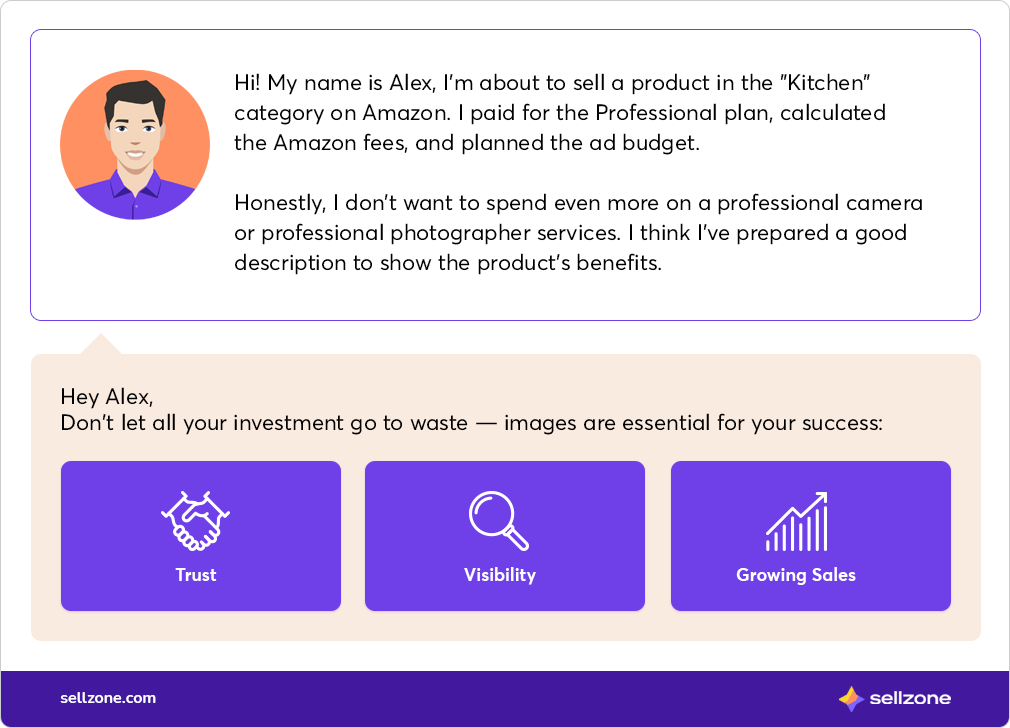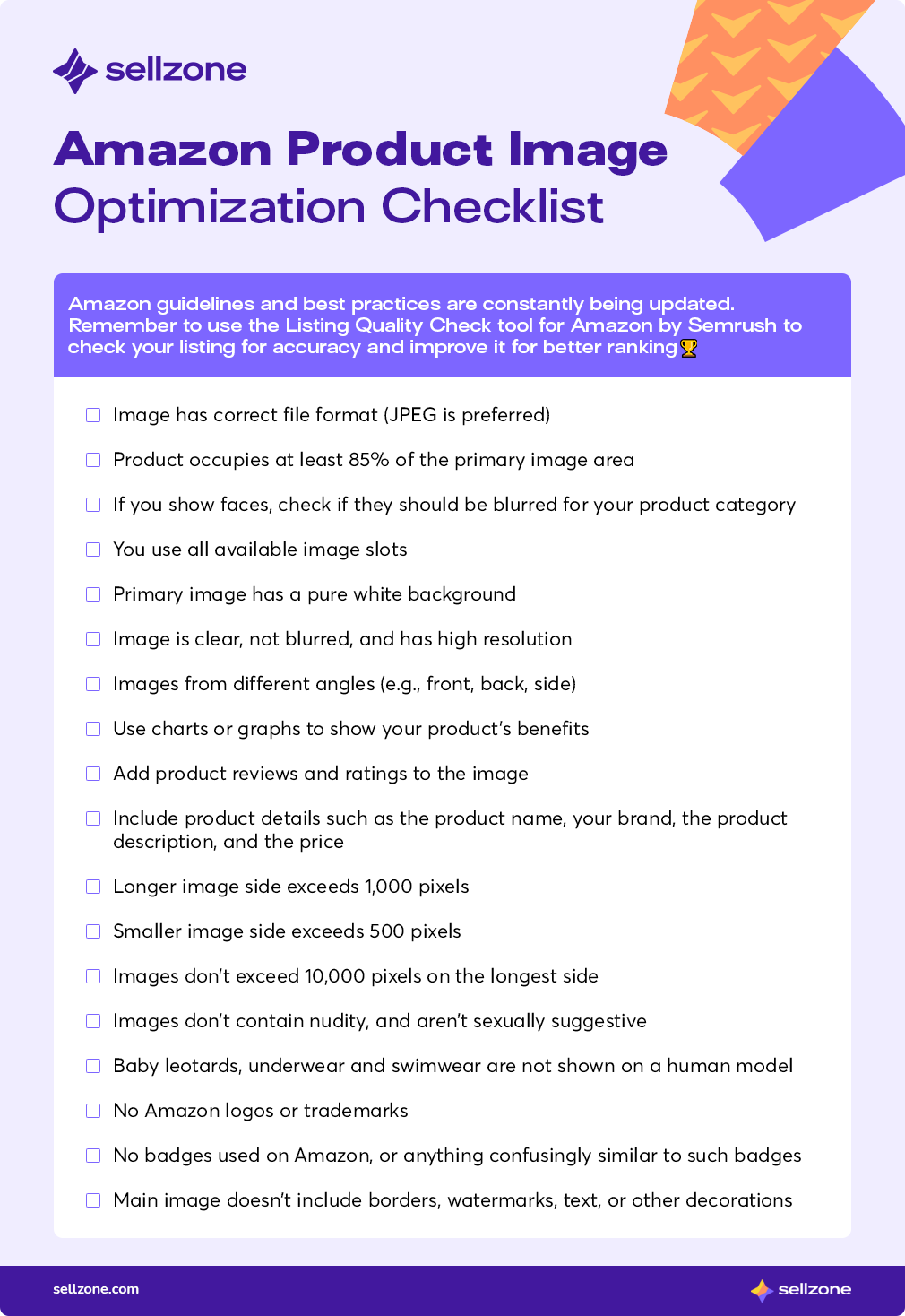10 Tips to Optimize Your Images on Amazon

As an Amazon seller, it's crucial to have high-quality product images that accurately represent your items. Customers rely on images to make purchasing decisions, so it's essential that your pictures are clear, well-lit, and show all aspects of the product. In this article, we'll share some tips on how to optimize your images for Amazon.
Optimizing your product images on Amazon is key to helping shoppers see what you offer and ensuring that they are visible within search results. Images can also help increase conversion rates by making it easier for shoppers to know what you have to offer and growing trust in your brand.
Suppose you start selling on Amazon or want to optimize your images further. This guide will give you a deeper understanding of how to do this and why optimizing your images is important.
We’ll cover how to optimize your images for increased visibility, Amazon requirements for photos, the importance of file size and resolution, and best practices for image dimensions and type.
Hi! This post is brought to you by Sellzone, a blog designed by Semrush to help your ecommerce business grow. Semrush is the online visibility platform trusted by seven million users and 30% of Fortune 500 companies. Take advantage of Semrush's ecommerce tools by entering Semrush AppCenter.
Follow us on social media to read the latest strategies from the ecommerce community, and don't miss new opportunities to increase your profits:
What Is Image Optimization?
Image optimization refers to all the actions you can take to make your images as visible as possible on Amazon. This includes making sure the image file is the correct size and type and using relevant keywords and alt text.
This can help you increase the probability of your images appearing in Amazon’s search engine and being clicked, which can lead to more sales.
Why Is Image Optimization Important?
Although a single image may not increase your sales by much, it can have a significant impact on your success.
This is especially true for B2B sales, where images can account for 80% of a shopper’s decision-making process. When you optimize your images, there are a number of benefits.
- It helps shoppers know what they’re clicking on. Images can give shoppers more confidence in their purchases because they can see exactly what they’re getting.
- It gives your product a competitive edge. When you optimize your images, you increase your probability of showing up in Amazon’s search results; this makes it easier for potential customers to find your product.
- It can increase your product sales. When customers are more confident in their purchase, they are more likely to purchase from you.

Amazon Technical Product Image Requirements
When it comes to Amazon image guidelines, they have clear image requirements.
Before you optimize your images, you’ll want to ensure they are in the correct file format and dimensions. Amazon accepts many image types and file formats, including JPEG, GIF, and PNG.
However, you should avoid using BMP and TIFF images, as they can cause issues when uploaded. If you’re unsure how to upload your product photography or what type you should use, you can use this guide.
Also, when your product image size exceeds 5MB, it may appear as an error when someone is browsing your product.
See the checklist below to make sure your images are compliant with all Amazon guidelines and best practices:

For clothing items, books, and other products that feature a human model, you’ll need to have the person’s face either blurred or covered. For lifestyle images, the model can be shown with their face uncovered.
This is because Amazon prohibits images of nudity or sexual activity. For all other products, you’ll need to have the product take up 85% of the image. This is what Amazon calls product density, and it’s used to help customers quickly identify the product they’re looking at.
You can include either a text overlay or a watermark for pricing information. When you add pricing information to your image, it’s a good idea to ensure it’s not too distracting.
Types of Images and When to Use Them
According to the Anatomy of a Bestselling Amazon Listing, across all categories, the average image count for the bestselling listings is 7 (vs. 6 for non-bestseller). This implies that you should try using all available image slots and not limit yourself to only product images.
So, it’s essential to know what type of image to use and when to use it. While there isn’t one rule for all products, you can apply a few general rules to help you decide which image type to choose.
Product Image
When possible, you should use a product image. This should show shoppers what they're purchasing in an easy-to-understand way. Product images are especially important if the product has multiple parts, or if it's difficult to understand. Photo of the Product in Use
If you sell products used in everyday life, like kitchen appliances or tools, show how the product is used in its intended environment.
360-Degree Images
If you’re selling items with a unique design, like jewelry, lamps, or furniture, you should consider using 360-degree images. These images allow customers to view your product from every angle. The image frame should include the product with a pure white background.
Product Images with Text
You might want to combine an image with text if your product is large or complex. This is especially important if you want to include more information than might fit in an image. The primary image should be of the product, and the text should be superimposed on the image.
Realistic Images
You should use realistic images if your product is a consumable good, like food or beauty products. This makes it easier for shoppers to understand what your product actually looks like.
Tips to Optimize Amazon Product Images
Use High-Quality Images
How do you get images for Amazon products? The first step in creating great product images is to use high-quality photos. Your customers can tell if an image is blurry or has a low resolution, so it's essential to use clear, sharp pictures.
If you're not a professional photographer, you can hire one to take pictures of your products. Or, you can use a photo editing software like Adobe Photoshop to improve the quality of your images.
Use Different Angles
Another important tip is to use different angles when photographing your products. In addition to the main image, you can upload up to 8 additional images per product listing.
These images can be close-ups of different details or views of the product (e.g., front, back, side). This will give customers a better idea of the product and help them make a more informed purchasing decision.
Use Infographics
Including infographics in your product images can also be helpful. An infographic is an image that contains information or data, usually in the form of charts or graphs.
Infographics can be used to highlight the features or benefits of your product. For example, if you're selling a computer, you could include an infographic that compares the specs of your model to other similar models on the market.
Optimize Your Images for Search
In addition to ensuring your images are high-quality and informative, you'll also want to optimize them for search. This means including keywords in your images' file names and alt text.
When customers search for products on Amazon, your product images will appear in the search results. Including keywords in your image file names and alt text will help ensure that your images appear in the relevant search results.
Test Different Images to See What Works
Not every image works for every product, so you should test different images to see what works best for your products. You can create different variations of the same image or use different angles and poses. Ecommerce experts Jenn Johnston and Dan Saunders recently discussed how to get strategic about split testing, and we collected the most important points from their discussion in a post.
Include Relevant Product Details
Not only should your images be clear, but they should also be easy to understand. Make sure to include product details such as the product name, your brand, the product description, and the price. This will help shoppers easily understand what they’re looking at.
However, this information can be placed on the additional images only. Main images cannot have additional graphics added to them. This includes badging such as "stamps of approval," logos, text explaining product features or quantity, shipping options, copyright notices, email addresses, or watermarks of any kind.
Add Product Reviews and Ratings
If you’re selling a product used in everyday life, like a kitchen appliance, you can add product reviews and ratings. This can help shoppers more confidently make a purchase.
Use Relevant Keywords
When you optimize your images, you should also use relevant keywords. This will make it easier for people to find your images when searching for products. This post reveals some hacks that can help you get away without using a specific tool, but if you want to be smart about your keyword strategy and utilize data for one of the most crucial elements of Amazon SEO, we suggest that you follow this workflow that involves keyword insights from Semrush’s Keyword Wizard tool for Amazon.
Use Product Videos
Remember that another way to enhance your product is to use videos. You can upload up to five video files per product listing, and each video can be up to 5 minutes long.
Videos are a great way to show customers how your product works or its features. They can also be used to answer frequently asked questions about the product. Check out three proven methods on how to add videos to your Amazon listing.
Final Thoughts
Images are an essential feature of any online product listing. Following the tips above, you can create great Amazon product images to help you sell more products. High-quality, informative, and well-optimized images can help you attract more customers and increase sales. So, take some time to improve your product photos and see the difference it makes to your business.
You've read to the end, you rock! Follow us on social media, and don’t miss new opportunities to increase your profits:
Read further:
Ready to grow and scale your e-commerce business? Online retail is a bustling business, but it doesn’t come without challenges. So be careful to avoid these top 5 e-commerce mistakes that can cost you your customers.
